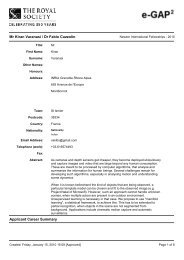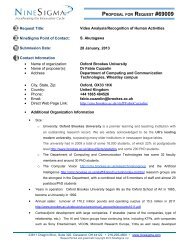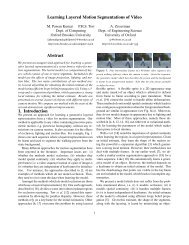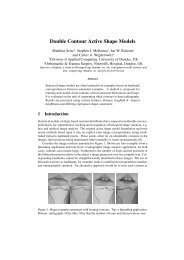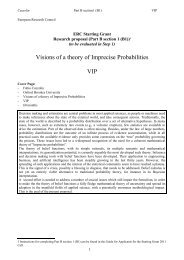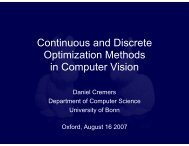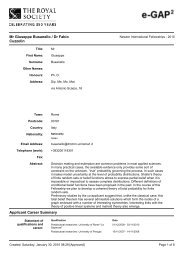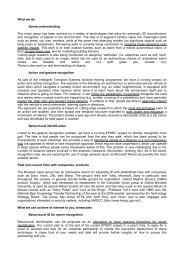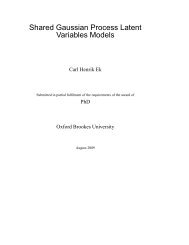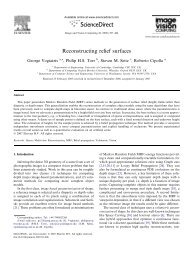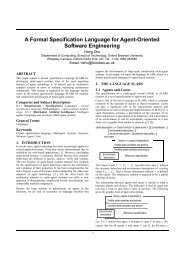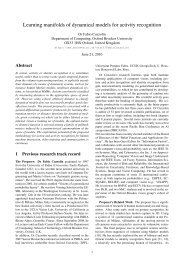Project Proposal (PDF) - Oxford Brookes University
Project Proposal (PDF) - Oxford Brookes University
Project Proposal (PDF) - Oxford Brookes University
You also want an ePaper? Increase the reach of your titles
YUMPU automatically turns print PDFs into web optimized ePapers that Google loves.
FP7-ICT-2011-9 STREP proposal<br />
18/01/12 v1 [Dynact]<br />
Based on the general ideas and methods developed by the SYSTeMS-IDSIA teams and described recently in<br />
[62,63], we will derive formulae for the probabilities of such sequences in imprecise HMMs that lend<br />
themselves to backwards recursion, and therefore to generalisations of the backward algorithms to precise<br />
HMMs, essentially linear in the length of the Markov chain.<br />
SubTask 1.2.2. - Computation of lower and upper likelihoods<br />
These are the lower and upper probabilities of the observation sequences. Backwards recursion calculations<br />
for these entities should also be possible, based on the seminal work in [62,63].<br />
SubTask 1.2.3. - Most probable explanation<br />
The "most probable explanation" for precise HMMs consists on finding the state sequence (explanation)<br />
with the highest probability, conditional on the observation sequence. In an imprecise probabilities context,<br />
there are basically two ways of formulating this problem [94]. The "maximin" method is a pessimistic<br />
approach which seeks the state sequence with the highest lower probability, conditional on the observations.<br />
In the "maximality" method, one state sequence is considered to be a better explanation than another if it has<br />
a higher posterior probability in all the precise models that are consistent with a given imprecise model.<br />
Preliminary analyses [64] hint that the latter method is most likely to be able to be implemented efficiently.<br />
Task 1.3 - Imprecise EM for hidden Markov models<br />
Task 1.2 is about making inference on imprecise HMMs, however learnt. Yet, learning imprecise HMMs<br />
from video sequences is not trivial, as the number of operation to be performed for each iteration of the<br />
algorithm can grow exponentially with the input size. This task involves:<br />
SubTask 1.3.1 - Specialisation of the EM algorithms to the HMM topology<br />
The imprecise EM developed in Task 1.1 has to be first specialized to the special case of HMMs, based on<br />
the inference algorithms developed in Task 1.2.<br />
SubTask 1.3.2 - Implementation of recursive formulae for parameter updating<br />
Recursive formulae describing the revision of model parameters have to be determined.<br />
SubTask 1.3.3 - Convergence and initialisation: empirical study<br />
The convergence properties of the EM algorithm, specialised to the HMM topology, have to be assessed. Its<br />
robustness and the quality of the estimates with respect to parameter initialisation (a crucial issue even in the<br />
precise case) needs to be considered as well.<br />
Task 1.4 - Imprecise Dynamical Graphical Models<br />
HMMs are an example of probabilistic graphical models with a dynamic component, in a way the simplest<br />
example of dynamic Bayesian networks. A general theory for dynamic BNs is well established, but a similar<br />
comprehensive framework is still missing for credal networks, the imprecise-probabilistic generalisations of<br />
Bayesian networks. Contributing to the development of such a general theory is the final aim of this work<br />
package, paying special attention to higher-order HMM topologies able to provide a better model of the<br />
correlation between the frames of a video sequence depicting an action. We also intend to explore the<br />
possibility of modelling these relations by means of undirected graphs, providing a generalisation of random<br />
Markov fields (which are already widely used in computer vision) to the imprecise probabilistic framework.<br />
SubTask 1.4.1 - Dynamical (and object-oriented) credal networks<br />
A crucial step consist on investigating whether the ideas pioneered in [62,63] for inference in credal trees can<br />
be extended to more general types of probabilistic graphical models. Methods will then have to be devised<br />
for (recursively) constructing joint models from the local imprecise-probabilistic models attached to the<br />
nodes of such credal networks.<br />
SubTask 1.4.2 - Inference algorithms and complexity results for dynamic credal networks<br />
Based on those (recursive) methods for constructing joints, recursive or message-passing algorithms need to<br />
be developed for updating these networks based on new observations, computing lower and upper<br />
probabilities, likelihoods, and most probable explanation.<br />
SubTask 1.4.3 - Imprecise Markov random fields<br />
Markov random fields are graphical models based on undirected graphs particularly suited for modelling<br />
pixel-to-pixel correlation in image analysis [85]. The extension of our inference techniques to imprecise<br />
Markov random fields is potentially of enormous impact and will be pursued towards the end of WP1.<br />
WP2 – Classification of generative dynamical models<br />
Once represented video sequences as either precise or imprecise-probabilistic graphical models (for instance<br />
of the class of imprecise hidden Markov models), gesture and action recognition reduce to classifying such<br />
generative models. Different competing approaches to this issue can be foreseen.<br />
Task 2.1 – Dissimilarity measures for imprecise graphical models<br />
SubTask 2.1.1 - Modelling similarity between sets of probability distributions<br />
<strong>Proposal</strong> Part B: page [14] of [67]



